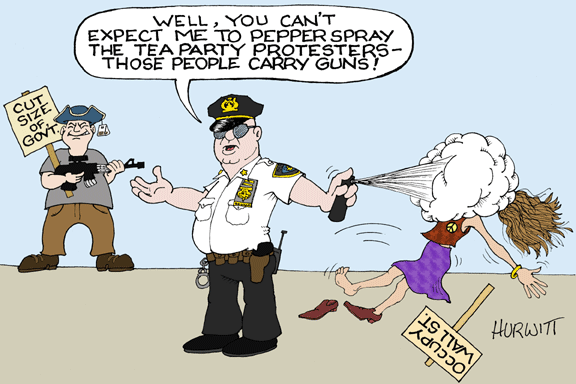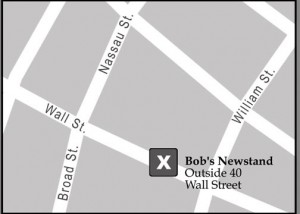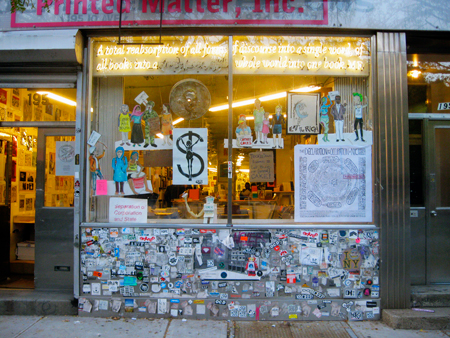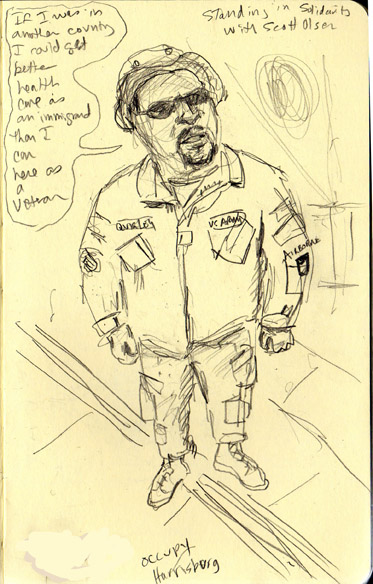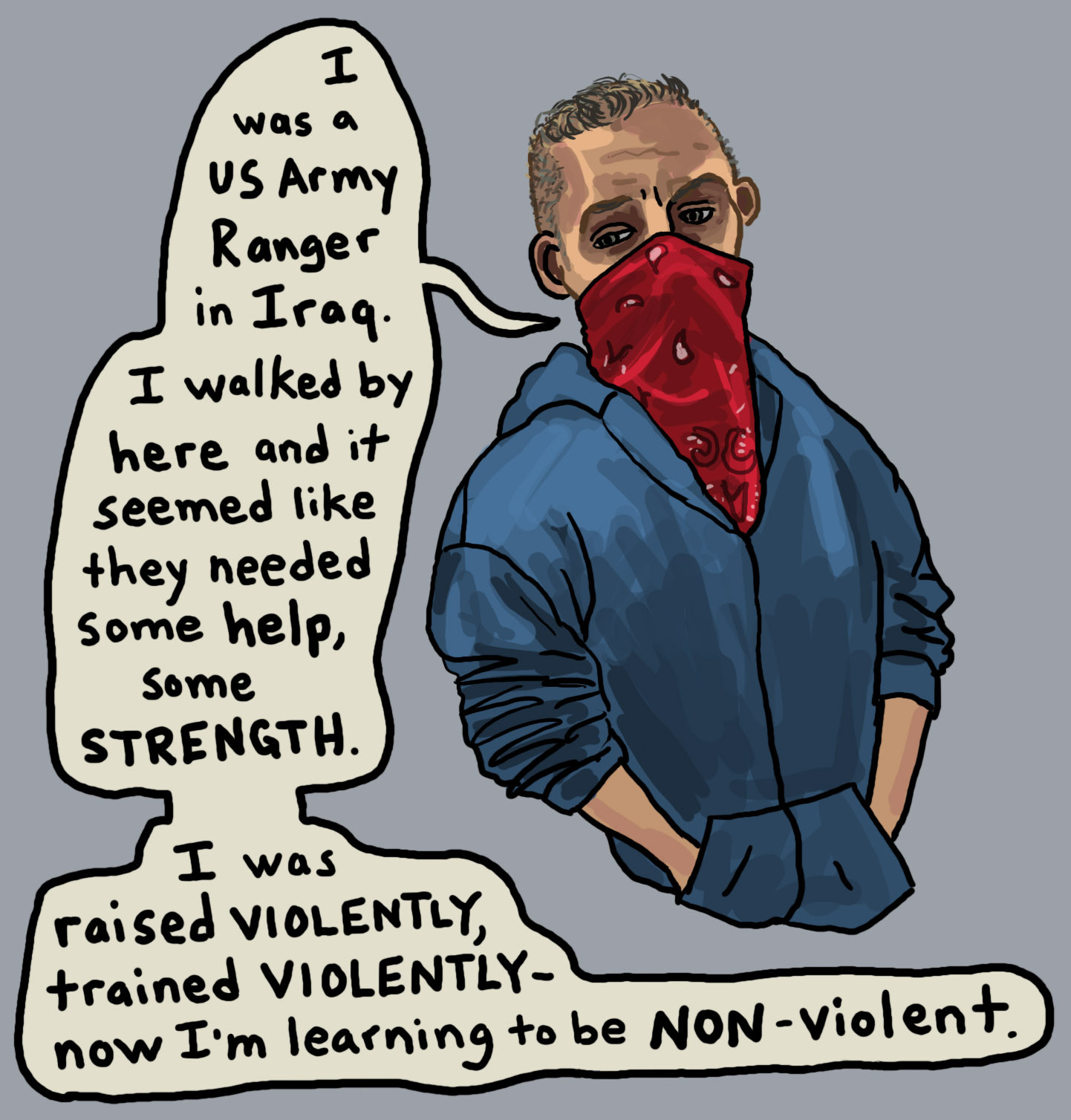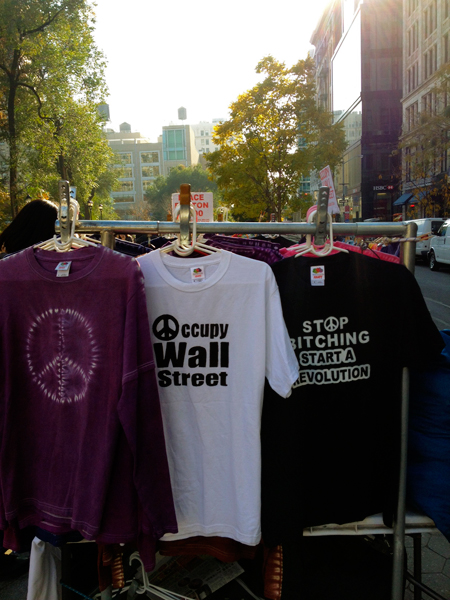The Occupy with Art blog provides updates on projects in progress, opinion articles about art-related issues and OWS, useful tools built by artists for the movement, new features on the website, and requests for assistance. To submit a post, contact us at occupationalartschool(at)gmail(dot)com .
Curb Exchange
 Saturday, November 12, 2011 at 01:25AM
Saturday, November 12, 2011 at 01:25AM 
Please join us on Sunday, November 13 for Curb Exchange, a self-guided audio- and print walking tour of Wall Street that explores the history of the neighborhood and the financial system from the perspective of the people. Come and learn about the historic struggles that have led to the rise of the Occupy Wall Street movement!
We are proud to be endorsed by the Arts & Culture NYC General Assembly Working Group. We encourage the 99% — including all occupiers, supporters, activists, volunteers, and citizens — to take the Curb Exchange tour, which explores the history of the neighborhood and the global financial system it has come to symbolize from the perspective of the people.
We'll be meeting up at newsstand outside of 40 Wall Street on Sunday, November 13 at 2 pm. Download the audio tour beforehand at www.curbexchange.org.
 curb exchange,
curb exchange,  history,
history,  occupy wall street in
occupy wall street in  tours
tours SOUNDS FROM OCCUPY LA
 Friday, November 11, 2011 at 02:27PM
Friday, November 11, 2011 at 02:27PM [FROM GX JUPITTER-LARSEN]
Noise I've recorded from OLA
FYI (please feel free to share):
http://jupitter-larsen.com/noise/occla.09.11.2011.mp3
http://jupitter-larsen.com/noise/occla.07.10.11.mp3
http://jupitter-larsen.com/noise/occla2011.mp3
I've been posting these on different blogs of mine...
Such as:
http://gx-communique.blogspot.com/search/label/Occupy%20LA
Keep up the great work...
ALL THE BEST
GX
OCCUPIED BLUESTOCKINGS
 Friday, November 11, 2011 at 11:28AM
Friday, November 11, 2011 at 11:28AM 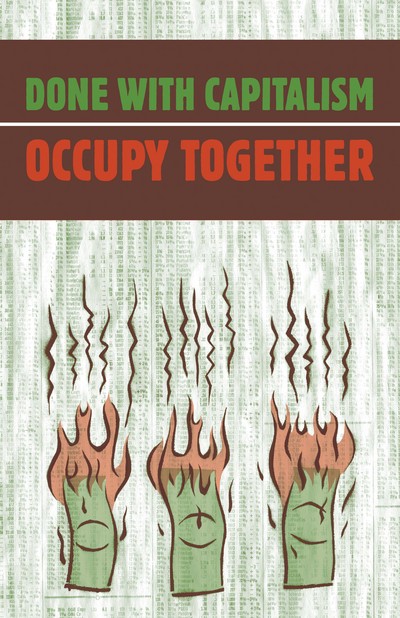
OCCUPIED: AN OCCUPY MOVEMENT GROUP SHOW
EXHIBITION: NOVEMBER 14TH THROUGH DECEMBER 8TH
OPENING RECEPTION: MONDAY, NOVEMBER 14TH, 7-10PM
OCCUPIED, is an art show and events series inspired by the evolution of the Occupy Wall Street Movement, hosted by BLUESTOCKINGS. Over 30 artists from around the world contributed posters, prints, signs, photographs, drawings/works on paper, and multimedia installations. The show opens Monday NOV 14th and runs through DEC 8th, 2011. The show and events series is intended as a "cultural benefit" for OWS Arts&Culture and BLUESTOCKINGS. It will be a vehicle through which to engage in dialogue and contemplation of the OWS movement thus far.
Come out to BLUESTOCKINGS this MON NOV 14th @ 7PM to celebrate the opening night of OCCUPIED featuring artwork inspired by, and from artists working with the Occupy Wall Street Movement. Tonight’s program also includes performance, music, food, drink and discussion. The exhibition will be up through Thursday, December 8th.
OCCUPIED: AN OCCUPY MOVEMENT GROUP SHOW runs November 14th thru December 8th at Bluestockings 172 Allen St, NYC, NY (1 blk south of Houston St @ Stanton, 2nd Ave stop on the F train). The opening party is Monday November 14th, 7 to 10pm, is free and open to the public. For more information contact Bluestockings at 212-777-6028 or art@bluestockings.com. www.bluestockings.com, http://www.facebook.com/event.php?eid=154380834660987, http://www.facebook.com/bluestockingsnyc
BLUESTOCKINGS is a volunteer powered and collectively owned radical bookstore, fair trade cafe, and activist center in the Lower East Side of Manhattan. Through words, art, food, activism, education, and community, we strive to create a space that welcomes and empowers all people. We actively support movements that challenge hierarchy and all systems of oppression, including but not limited to patriarchy, heterosexism, the gender binary, white supremacy and classism, within society as well as our own movements. We seek to make our space and resources available to such movements for meetings, events, and research. Additionally, we offer educational programming that promotes centered, strategic, and visionary thinking, towards the realization of a society that is infinitely creative, truly democratic, equitable, ecological, and free.
 BLUESTOCKINGS,
BLUESTOCKINGS,  Occupy everywhere,
Occupy everywhere,  occupennial in
occupennial in  alliance,
alliance,  events,
events,  exhibition
exhibition The Blanket
 Friday, November 11, 2011 at 10:47AM
Friday, November 11, 2011 at 10:47AM I hear change.
Pressing my ear to the earth and its stirring bones,
baby vibrations kiss my skull,
I close my eyes and smile;
I detect approaching footfalls.
In conversations, the sketchy sparks of electrified embryos,
these restless hatchlings of hybrid hopes
spring from incubation, fall from lips and
onto my shirt, shoes and into the dirt we walk on.
They are not lost shards of fragmented dreams.
I choose to believe they are seeds.
I hear change.
Surrounds me: a lyric of tongue spoken with hands and feet,
a melody of ideas, philosophy, theology
married to passion in search of a savior
fashions a harmony, this whispered anthem
scratches my ear.
It is not an elegant sound, these staccato pinging
sutures of suffering sewn into faces
of mommies and daddies staring at babies
unconscious to thundering ticks of time
countdown seconds to roll call;
masses lined up for closeted stations in Purgatorio Nuevo.
And notes of simpatico silence as cellos
mourning the passing of faith in the night,
struggle to harmonize poorly with courage,
that blood of the ages which oils fear and flight;
I hear it.
I sense change.
I cannot feel it. The wind won’t reveal it. I’m numb to its presence.
I find no evidence trail on my tongue,
nor DNA refugees hiding in fingertips.
These trained eyes strain to identify
its invisible silhouette walking among us, and fail.
Yet, it is coming.
I know this because it is cold in here.
I should be shivering but I am not.
An other-earthly cloak has fallen,
cast around myself, its warmth just barely
coats me with a holy intuition.
Wrapped and huddled on front porch step,
eyes fixed upon that dark horizon
expectation welds me to this patient space
where, as prodigal children returning to rescue,
christening streaks of breaking light
will herald our transformation.
2011 Sojourner109
 occupennial,
occupennial,  ooccupy wall street,
ooccupy wall street,  poetry in
poetry in  poetry
poetry From the Brooklyn Rail
 Friday, November 11, 2011 at 08:55AM
Friday, November 11, 2011 at 08:55AM TUESDAY, NOVEMBER 15 AT 7:30 PM
UNION DOCS // 322 UNION AVE. BK, NY
FREE // DONATIONS TOWARD FILM ACCEPTED

The Rail's Williams Cole will introduce and the Q&A will be moderated by Christopher Campbell, film critic for the Documentary Channel, IndieWIRE, and Movies.com, where he writes the bi-weekly Doc Talk column.

99% - The Occupy Wall Street Collaborative Film is a feature documentary film spearheaded by over 50 independent filmmakers, photographers, and videographers across the country. The end product will be a compelling, cinematic, resonant, and honest portrait of the Occupy Wall Street movement. Founded by NYC filmmakers Audrey Ewell and Aaron Aites, the project currently counts among its collaborative many award-winning documentary producers, directors, musicians, and editors (as well as PR people and distributors) including Michael Galinsky and Suki Hawley (Battle for Brooklyn, Horns and Halos), Ava DuVernay (distributor of independent black films via AFFRM, director/producer I Will Follow), Aaron Yanes as supervising editor (a frequent Barry Levinson editor, he's also edited many award-winning features and documentaries, from Sundance Grand Jury Prize winner Padre Nuestro to James Toback's Cannes prize-winning Tyson), Tyler Brodie (Another Earth, Terri), Bob Ray (Total Badass), and many more.
SPACE IS LIMITED. PLEASE ARRIVE PROMPTLY.
 documentary,
documentary,  events,
events,  film,
film,  occupy wall street,
occupy wall street,  video in
video in  discussion,
discussion,  documentary
documentary UPDATE: Occupy Printed Matter
 Wednesday, November 9, 2011 at 09:56AM
Wednesday, November 9, 2011 at 09:56AM [Click the image to read the excellent Hyperallergic review of Occupy Printed Matter by Liza Eliano. Phase 2 of the evolving installation of Occupant art at Printed Matter will begin on Saturday. Contact Adrian Rocchio (see Printed Matter Storefront in the Active Project Proposals on the left sidebar for contact info] to find out more. One note from Max Schumann of PM: Please keep your submissions/dimensions @12-14" in any direction. Some wiggle room on that, but check out the image above. Big paintings/prints/signs/sculptures will occupy the space we're all trying to share. A screen-printing event is in the works for Saturday, and we'll pass on more details as they emerge. What a great first Occupennial project! Kudos to all!]
Adrian's Update:
The Printed Matter window installation is first and foremost a way to help spread the #occupywallstreet message to the doorway of the Gallery district. But it also provides #OWS artists a way to both learn from and engage in tribute to their art activist forebears.
Paul from Occupennial had visited Printed Matter for their retrospective of Colab. He announced at an Arts & Culture meeting that members of Printed Matter were offering their storefront and window for an #occupywallstreet art installation. He also reminded us that artists from various reputable art groups were themselves occupying Liberty Plaza, including those from Colab. I volunteered to take lead in organizing the window installation and two battle-scarred members of our working group volunteered to help. Two newer members of Arts & Culture also offered their time.
I first did research on the organizations involved. Since I had visited Printed Matter before I knew a little of their work. However being a spoiled New Yorker I figured it was one of many types of specialty book stores. Had I been more productive in my artistry or been active in researching artists’ publications I would have discovered soon enough that Printed Matter was not only one of a kind but a valuable organization. My research also brought me knowledge of the Colab collective. It was my immediate impression that if the OWS Arts & Culture working group didn’t reflect the principles of agency, inclusiveness, collaboration, and empowerment, indicative of the Colab collective, then I had never understood the meaning of kindred spirits. For not only did Colab produce engaging art they developed a way to do it outside bureaucracies. In point of fact, one of Colab’s resolute and successful endeavors was to attain public grants and funding without the necessity of middlemen and administrators.
On curating I found these three steps to be helpful. The first is to do research on the organization, venue, and participating artists or organizations. Second, is to have necessary documents prepared in advance. And the third, to solicit artwork from artists while informing them of their rights. All these things I learned while in the process of doing the installation. After making pre-production list of things that needed to be done, I wrote a quick summary of the organization to inform potential contributors about Printed Matter, their offer to us, and our goals.
I set up a new thread in the New York City General Assembly / Arts & Culture forum informing artists of the space and history of Private Matter and about Colab. I then emailed guild co-organizers the same information as that in the forum, with the inclusion of contact information, and asked them for assistance in providing artwork. These two steps were done immediately for the fact that the Printed Matter space was already available.
I planned on creating a list of artwork to be contributed so that my team could discuss how they would be displayed and to determine whether there would be theme or how we will rotate it. I also planned on creating an inventory and to make consignment "receipts" for contributors and secure transportation or a method of delivering work.
The first contributors to offer work were those who had been attending Arts & Culture meetings and who responded quickly to email requests. The first artists to contribute work included puppeteers, painters, and a performance artist. My first attempt at coordinating the pickup went well. I met two artists at Liberty Plaza and picked up handmade posters from Archives. That Saturday Imani Brown and I went to a donated Dumbo art studio to pick up puppets. We then met Johnny Sagan (a.k.a. Snowy Wilderness), Claudia Vargas, and Vance Dekker-Vargas at Printed Matter to set up the work. The installation was fun and after a few changes the composition was complete.
The wonderful Flowchart of the Declaration of the Occupation was designed by a woman who wishes to remain anonymous but who can be contacted at flowchartart@gmail.com. Noah Fischer contributed a Washington quarter mask. One of a collection of iconic masks used in his Summer of Change 2011 performance, “a series of numismatic ritual offerings to our nation’s bankers; those citizens worthy of prizes and honors; which we as artists are honored to bestow in public.” This pre-Occupy Wall Street performance was momentously aligned with the Occupy Wall Street’s message and continues to represent the cents-less tribute the masses pay to financial district deities who we must reason truly have our best interests at heart even if and especially when their mysterious ways devastate individuals and communities. The puppets were contributed by the Puppetry Guild of Arts & Culture. Artist ______ mixed media collage is titled “Eat the Rich” 2011. Her son Artist _______'s work is titled “Thirst” 2011 and was made with acrylic spray paint on paper. Handmade signs, drawn on-site through the weeks of the occupation, were consigned from Archives of #OWS.
Everyone at Printed Matter has been helpful if at times busy with their own work. Max has been incredibly helpful and is always available when needed. We have already acquired work for this coming Saturday and hope to have performers, musicians, and a screen printing table setup outside. I’ve posted a new topic in nycga.net titled Occupy Chelsea in the hopes that this call at Chelsea’s threshold may the first of many exhibitions: “Fiery Occupy Chelsea rises, deep thunder rolls around its shore, burning with the fires of Orc.” (William Blake modification)
Best,
Adrian Rocchio
>
PRESS RELEASE FROM PRINTED MATTER
Printed Matter is pleased to announce a collaboration with Occupy Wall Street, co-ordinated by the OWS Occupennial and a team of occupant artists. Through November 26th the Printed Matter storefront window will feature Occupy Printed Matter, a rotating installation of work created by artists participating in the #OccupyWallStreet arts and culture working group, the inaugural artist action from that committee. The political, social and cultural impact of OWS and the broader Occupy movement has already been widely felt; it is our hope that providing a modest outlet in Chelsea will serve both as an expression of solidarity with the movement and an opportunity to extend its reach into new communities.
The installation, which includes work of varying media from several dozen occupant artists, will change over the course of the month as new material is created in response to transpiring events. Work currently includes a large scale Flow Chart for the Declaration of the Occupation of NYC, a coin-shaped mask from the 2011 Summer of Change, a spray-painted poster calling for the Separation of Corporation and State, as well as cut-out demonstrators voicing the fundamental concerns of the movement.
Printed Matter will host a series of events on the remaining Saturdays in November, 12-5 PM, during which visitors are invited to make artwork reflecting their economic/political demands. Drawings and writings will then be screenprinted by OWS onto cards and added to a bulletin board for display outside of Printed Matter.
The window installation coincides with Printed Matter's exhibition A Show about Colab (And Related Activities), on view through the end of November. Active in the late-seventies through mid-eighties, Collaborative Projects, Inc. has a compelling relationship to OWS: Historically, Colab came together in the wake of the 1970's recession and on the eve of Reagan's ushering in the era of financial deregulations and social austerity, which continues to this day. Organizationally, like OWS, Colab was set up to be non-hierarchical and inclusive with open meetings and rotating officers. Occupy Wall Street has invited former members of Colab to contribute to the installation, while some Colab alums have been active in OWS demonstrations and assemblies.
 occupennial,
occupennial,  occupy printed matter in
occupy printed matter in  exhibition
exhibition The Artist as Worker
 Wednesday, November 9, 2011 at 09:27AM
Wednesday, November 9, 2011 at 09:27AM By Lisa A. Miles
The scare and struggle surrounding a person’s livelihood has suddenly become common denominator in this country. Workers simple and schooled, both with equal pride, have faced significant questions about the integrity of their professions, let alone the viability of their chosen occupations. Auto workers and bankers looked for signs last year– newfound public appreciation or government help spurring sales, confidence in the market, or perhaps literally the blinking exit to another arena to save face.
One group of professionals has continually weathered this storm, however. The nation’s artists. As to whether it makes it any easier to ride out, when many are now suffering, remains to be seen. But due to their strong sense of identity (and the fact that they are used to being poor) they will come out the other end intact– more than can be said of other occupations.
Artists as workers is a concept still un-embraced, despite FDR’s inclusionary attempts with the Works Progress Administration of the 1930s. Artists almost flourished for a small time then. Notice the talk is of artists, here– not so much art organizations. (Much could be written, with artist testimony, on the questionable support of arts organizations to this nation’s actual individual artists.) This definition includes but is not limited to musicians, theatre artists, filmmakers, painters, writers, sculptors, poets, dancers, storytellers, photographers, composers, performers and illustrators (and especially the independent ones, creating new, not derivative, work).
Like the nation’s newly unemployed or underemployed, creative artists are constantly searching for work, looking for viable opportunities for their skills, remaking their roles to fit current needs, and struggling to make ends meet.
Some of the more successful artists are simply blessed with being more resilient and lucky. All those with genuine talent, though, and with an accumulated body of work (albeit little money) have an integrity that can not be swayed externally from their already fragile position. All deserve a better lasting situation in our American society.
The most visible products to come out of the WPA were the bridges and public park structures that many Americans are familiar with, so much in evidence still to this day. But the WPA had many subdivisions, one of which was the Public Works of Art Project, or Federal Arts Project. Its subdivisions were the Theatre Project, the Writers Project, and the Mural and Easel Projects. Produced in cities all across America were new works for the stage, writing both creative and to chronicle, and easel paintings, lithographic prints, posters, watercolors, murals and sculpture, plus more.
Works were made for and distributed to public schools, libraries, planetariums, city and county buildings, housing authorities, garden markets, post offices, park structures, and other tax-supported institutions. It was indeed a ‘shovel-ready’ project (or rather brush and pen) that utilized talent to meet need. Governing bodies other than the WPA partially funded the work. City and state governments and colleges were on board with the creative-economic collaboration. Private recipients included hotels, homes for the elderly and banks.
Associated with the Federal Art Project were the Museum Extension Projects, which employed (as described by program material of the time) “research-workers, draftsmen, artists, sculptors, photographers, model-makers, and other men and women from the professional and technical groups.” Just a bit of material produced: “models of historic locomotives, frontier forts, historic buildings and mankind’s homes the world over, all built from scale drawings based on authentic research; plastic replicas of fruits and vegetables, reptiles, and topographic relief maps; costume color-plates; dioramas; and puppets and puppet play scripts and properties.”
The major uses of the products were as instructional aids, but also for cultural and beautification purpose, with so many public and even private institutions benefitting. Early American reproduction items were produced, to be included in both the Index of American Design and a book on Americana sponsored by the Library of Congress. Historical societies employed writers’ summary essays, as well as theatre artists’ conveyances, of items cataloged in their collections. The value of such vast creative output was deemed a necessity in the realm of public education and cultural betterment for all of society.
Though likely much of the work produced for schools hasn’t survived the touch of youth, time itself hasn’t dimmed direct evidence that the WPA’s Art Project positively affected our nation. Arts project output can be witnessed in natural history museum collections display, and in murals and canvas still visible in public structures of every city– nostalgic momentos of a brief time when public policy actually addressed artists’ dire need for work.
The Great Depression was devastating to most people, and yet ironically, creative artists found themselves considered for the first time with their inclusion in President Roosevelt’s project linking viable work with skillful individuals in need. The economic downslide actually helped– for once, a means by which creative workers could earn a living with their abilities!
FDR’s programs were intended to give not a handout, but an opportunity (previously unconsidered) to employ workers. Homer St. Gaudens, director of the Carnegie Museum of Art, wrote in 1941 that the previous decade was one in which approx. 4,000 artists “were certainly in the submerged social strata. There was appropriated [with the WPA] a sizable sum with which artists, 90% of whom were to be on relief rolls, were [instead] employed at wages of from $69 to $103 a month.” (The American Artist and His Times, NY: Dodd, Mead & Co.)
Artists not only earned money for their basic livelihood, but gained a new sense of outward respect. Through the ages, they have either embraced self-worth or risked insanity. Now at least in the U.S. government’s eyes, artistic ability was finally seen as a viable part of society. Un-legislated individual viewpoints would prove much harder to change.
Former NEA Chair Jane Alexander spoke last year in support of the arts’ inclusion in President Obama’s economic stimulus package, on the heels of protestation by Lousiana Governor Jindal and others deriding what they did not want to understand. She of course well knew the increased stigmatization of the arts that took place in modern-day America at the time of Reagan’s de-funding of the NEA. Her words were significant, stressing the need and value of the country’s artistic output. For though FDR was mindful of the economic suffering of artists in addition to blue-collar workers, possibly enabling the general public to better understand their plight, any public good will would be soon enough squashed (as the Federal Arts Program would hit political pressure and the economy bowed to war).
The opportunity now in 2010, as we pull ourselves out of the Great Recession, is for the work of artists to take a new place in the economy. Discussing the benefits of WPA-like support for creative workers is called for. As well, when business and industry pick themselves up and dust off, they will need to take on Edgar J. Kaufmann’s courageous call for art in commerce. He who utilized art’s beautification in his Pittsburgh department stores, as well as commissioned Frank Lloyd Wright to build the masterpiece Fallingwater home, put out a call to muralists in a 1930 store pamphlet, and noted, “the fact that today we are the richest of nations places on us the added responsibility of giving greater momentum to cultural development than it has ever received from any people. Business and industry must accept a share of the responsibility which opportunity imposes.”
But let’s face it– most skills bring money in good times. Creative work has never, really. Dancers, writers, composers, painters, actors and more struggle every day to make a living. Creative artists, like all people, need work in order to survive. It is a terrible predicament to be good at something, to know you have a unique ability to do something that not everyone can, to even recognize that those abilities could creatively transform problems into solutions and certainly should have a place in our society– but to see little prospect of work.
All artists need opportunity to earn money utilizing their talent, doing what they do best. (This should be as much the American Dream as home ownership). That opportunity can be in so many forms, including (the very overlooked) schools and institutions hiring professional artists en masse for residencies; people hiring live musicians, esp. those writing original work (not simply derivative top 40 pop); community businesses adorning their walls not with usual-fare ‘doctor’s office prints’ but the work of local painters; performers and sculptors being commissioned to create for public and private enterprise; and grants and fellowships being awarded to individual artists who have a body of quality work to show the world, with more waiting in the wings.
In order for there to be work for artists, some subsidy may need to happen. In our land of plenty (should we be able to call it that anymore), it is certainly a shame that artistic ability has never garnered better wage. We have found our way around tremendous problems (and now stare at more daunting ones), and yet we have never tackled the idea that cultural work is indeed still work. That creative workers shouldn’t be always expected to live in poverty due to the (lack of) valuation of their skill.
For sure, artists got through, however narrowly, the slump– whether tagged recession or depression– intact. But they have always needed more than that just to get by, far beyond the here and now of common economic suffering. It is rather simple, really. Artists need to be employed– with consideration given to the full meaning of that word. Something with lasting impact is called for. Whether it be the jump-start of a Federal Program, or simply a long-deserved recognition and understanding from the rest of the country, spurring on employment opportunity. For indeed artists are workers.
Lisa A. Miles
@lisamilesviolin
www.lisamilesviolin.com
links:
http://workmagazinearchives.wordpress.com/back-issues/lisa-miles-8810/
http://davidandgoliathproject.wordpress.com/2011/08/
 art workers,
art workers,  occupennial in
occupennial in  art and work
art and work Seth's Excellent Proposal
 Wednesday, November 9, 2011 at 09:15AM
Wednesday, November 9, 2011 at 09:15AM 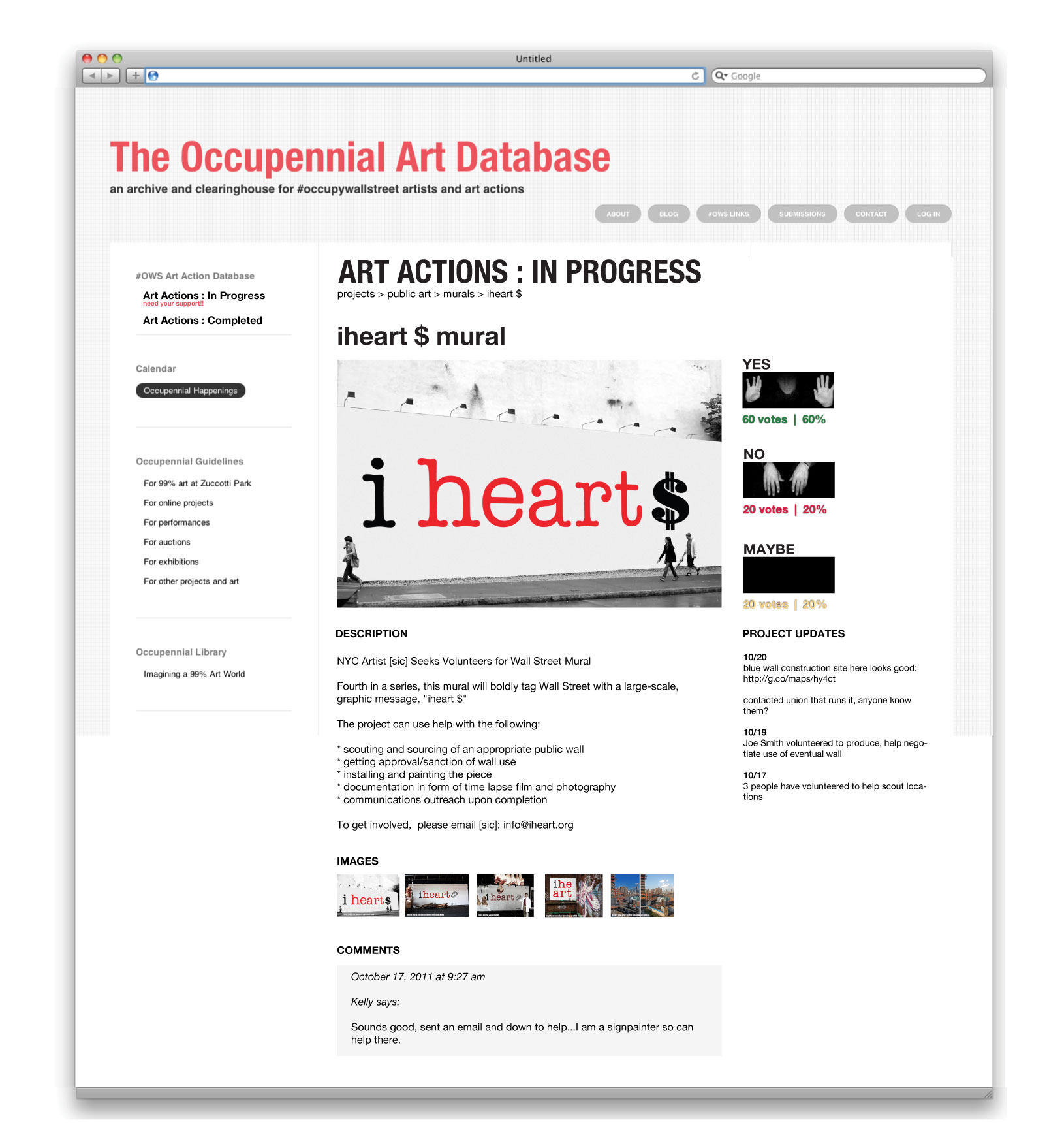 Hi all,
Hi all,
I spent some time thinking about the systems afoot so far and want to contribute with constructive design suggestion for the internet communications meeting in-person, particularly how to improve process of direct art action, aid and organization. I CCed open source contacts as well because it's an IT topic as well.
A few things have resonated with me so far in one meeting I attended and reading this list. First are the people numbers breakdown, 300+ on Arts & Culture list vs 30 who go to daily meetings and even smaller amount with much energy steering things moreso than others (no fault or critique, just how things can go, esp in current structure).
Then there are the two sites for Occupenial and Arts & Culture…weighted heavily towards an archivist model, moreso than actions of proposing, inputting and making art. By archivist, I mean that with Arts & Culture site it's all meeting/notes/docs and with Occupenial, mostly a date-based archive with blog entries that get lost as time passes. These are more venues for recording what already happened and discussing those events.
What may help to balance equation and help any newcomers and existing members online is a future forward dynamic that can augment and stand alongside this dominant archivist model. This would be a system addition that focuses on filtering ideas and people power into art making, proposing and realizing ideas, noting skills to contribute, and volunteering to help.
In doing so, and having a constant tally from all members possible on a given project, plus idea of members willing to contribute to it…there can be a nice synch between what's prioritized in in-person meetings, on the list, and on websites. It could also be an easy launch point for anyone new with any idea…i.e. organize, upload it, announce it on list and in-person…see what happens while working on it anyway.
I threw together the attached mockup built off Occupenial website, mostly because it seems the site can be customized somewhat more than Arts & Culture, also there's the word "action" in there :) So on left there you'll see Art Actions In Progress vs Completed.
I used my mural idea as the filler content because it's on-hand. The photos of hand gestures come from the General Assembly PDF (there's no photo of Maybe / Lukewarm gesture so left blank for now).
Votes could be instantly tallied by anyone clicking on the picture or word. It would likely require logging in to create an account to at least minimally prevent gaming the system. In-person meetings about specific projects would prove whether the online voting, input and energy is matched on the ground by real people. On left side I divided the main categories between Art Actions In Progress and Art Actions Completed.
Each project could have a direct and static link which could always be posted when anyone talks about it on this list. It does not just have to be visual art projects…theater, performance, events, and even the living documents all work fine. And just as Occupy started from creative/arts base, this system put through test of art activities may work work on broader scale, ie it could be used for General Assembly stuff like marches or other proposals.
By seeing what attracts the most interest from the body as a whole, the respective members can then focus and help enable those projects. A few people could track which projects get the most steam and relay rankings now and then via the email list with links so people can check in and input. This could also inform the setup and priority of things discussed and acted upon at the in-person meetings. It's a check on power of the few and also allows remote/online members to participate more.
I don't have time or skill to build this but this attached design is enough for someone with back-end capabilities…there would need to be project upload section and server setup to deal with assets and categorization of projects (the cookie crumb trail thing you see under main header). And there's simple auto actions like showing most active 5-10 projects and probably good idea to have curated set of projects to for compare/contrast.
I'm happy to share this Illustrator file if there's a builder interested and could help a bit more.
Best,
Seth
 occupennial,
occupennial,  proposals in
proposals in  proposals
proposals Portraits of the Occupation
 Wednesday, November 9, 2011 at 08:44AM
Wednesday, November 9, 2011 at 08:44AM Click to the image to visit a great new blog featuring occupational portraits, where artists can digitally submit images for posting. The blogger is linked to Sharon & Aaron's comix site, which also features some of Sharon's new Occupy comix/portraits of occupiers (see the Occupennial Political Cartoons section for a link, or click on the picture below).
 cartoons,
cartoons,  occupennial,
occupennial,  occupy wall street in
occupy wall street in  graphics
graphics A Message from Dallas
 Tuesday, November 8, 2011 at 06:46PM
Tuesday, November 8, 2011 at 06:46PM Subject: Occupy Dallas Culture - Culture Committee - Creative Factory Occupy Dallas
Hello, my name is Goran Maric.
I am an artist, creative cultural producer, and am a member of Cultural Committee and Outreach committee at OccupyDallas.org
Creative Factory Occupy Dallas
http://www.creativefactoryoccupydallas.com/
Occupy Culture
http://occupydallasculture.tumblr.com/
Well, ever since the beginning of Occupy Wall Street, I and few other creative souls have been deeply moved by your organizational capabilities to get artists and other creative cultural producers engaged with Occupy movement. And not just that, but your ability to present it in a quite intelligent and organized manner is what I find extremely appealing.
Here, in Dallas, TX, we, creative cultural producers and visionaries are working hard to get our creative brothers and sisters organized, so that all of us, 99%, together, can utilize our creative potentials for the advancement of our causes, while at the same time work on cultural enrichment of people directly involved at the site of OccupyDallas, as well as of people in the city of Dallas.
We, creative cultural producers and visionaries at Cultural Committee of OccupyDallas believe that the creativity of people involved in these Occupy movements is what has made these movements thrives in the face of all obstacles that are coming toward us on a daily basis.
Also in cultural production, it is the creativity, we believe, that makes works of art excited and ultimately successful. In this analogy we believe that, ultimately, Occupy Movements throughout the world are the best works of art that are out there, and the people involved are the best artists for that matter, for it is people's, 99ers', creativity that makes these movements strive.
For that reason Cultural Committee created Creative Factory Occupy Dallas, an output of creative cultural producers, for we, creative cultural producers and visionaries, from Cultural Committee at OccupyDallas believe that each and every person is a creative factory whose output, the product has contributed to the ongoing struggle we, the 99%, are engaged in on a daily basis.
http://www.creativefactoryoccupydallas.com/
We hope an truly looking forward to further interaction with Occupennial.
For now our big Solidarity with Occupy Wall Street that is going on hand in hand with its creative cultural producers...
Solidarity
 Occupy Dallas,
Occupy Dallas,  Occupy everywhere,
Occupy everywhere,  occupennial in
occupennial in  alliance,
alliance,  occupations
occupations SpaceBank
 Tuesday, November 8, 2011 at 06:03PM
Tuesday, November 8, 2011 at 06:03PM 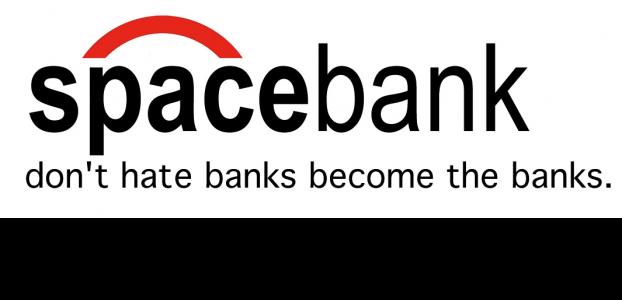
A Latin American virtual community investment bank trading online since the beginning of the Otra Campaña Zapatista in 2005.
Open your account with only $10 USD, and invest on the Brooklyn Stock Exchange <http://spacebank.org/bsex/>.
For exchange currency rate of the Digital Material Sunflower consult
--> http://palple.net/widgets/currencyconverter/
This was started by Eyebeam resident Fran Ilich: http://eyebeam.org/people/fran-ilich
Read Amelia Marzec's article about SpaceBank and OWS in the Huffington Post: http://www.huffingtonpost.com/amelia-marzec/artist-brings-virtual-cur_b_1080436.html
 banking,
banking,  eyebeam,
eyebeam,  fran ilich,
fran ilich,  money,
money,  ows,
ows,  spacebank in
spacebank in  participation
participation  Tuesday, November 8, 2011 at 05:51PM
Tuesday, November 8, 2011 at 05:51PM 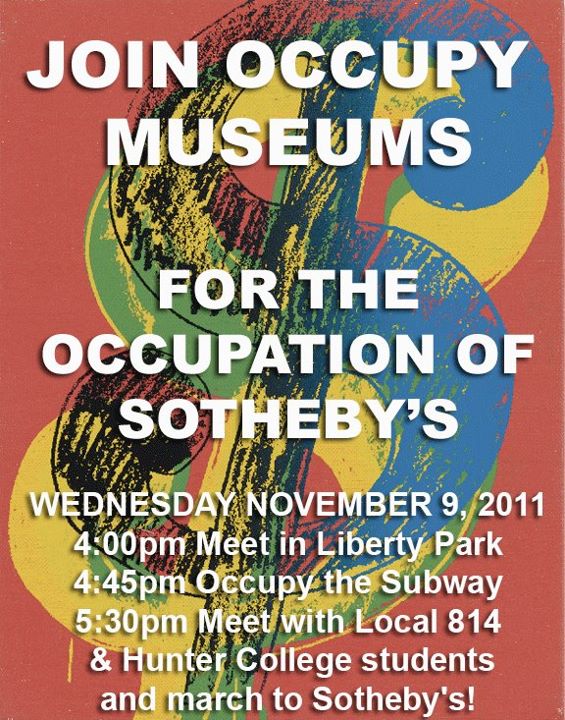
This Wednesday Occupy Museums once again stands in solidarity with the art handlers at Local 814 who have been locked out of their jobs for three months. Despite pulling in record profits last year, Sotheby's is demanding wage and benefit cuts and has hired unskilled replacement art handlers at a lower wage. The union has stood vigilant on the picket lines against these injustices for twelve weeks, but are still without a fair contract. Join us Wednesday November 9th, on the picket line outside of Sotheby's contemporary art auction to show your support and solidarity for Teamsters Local 814!
Schedule of Events:
Wednesday November 9th, 2011
4PM Meet in Liberty Park
4:45 Occupy the Subway
5:30 Meet with Teamsters Local 814 and Hunter College Students and March to Sotheby's!
Erik van Loon painting
 Tuesday, November 8, 2011 at 05:35PM
Tuesday, November 8, 2011 at 05:35PM 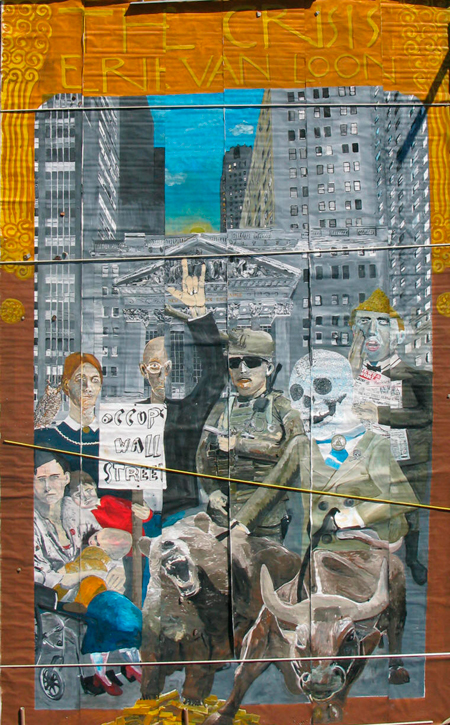
THE CRISIS:
Inspired by the political/financial problems I painted The Crisis. The Crisis is about a.o. greed, Wall Street, War, politicians, bankers and the media and two impressive paintings about the Great Depression:
- American Gothic (1930) from Grant Wood (USA) and
- Pillars of Society (1926) from George Grosz (Germany)
In The Crisis I painted (from right to left):
- the politicians reading right (republican) newspapers supporting
- the bankers, companies, corporations who are in charge and they give orders to
- the soldiers who threatens
- the people (farmers, disabled, children, etc) who want their money back
[ To learn more about Erik's occupation/other projects, visit his website http://www.erikvanloon.com/iww/iww7/press.htm ]
Open Letter to Mark Di Suvero re: Police Barricades of His Sculpture Joie De Vivre in Liberty Plaza.
 Tuesday, November 8, 2011 at 12:37PM
Tuesday, November 8, 2011 at 12:37PM Dear Mark Di Suvero,
We are artists and art workers forming the Arts & Culture working group of the Occupy Wall Street (OWS) movement.
OWS is a people-powered movement inspired by popular uprisings in the Middle East, Europe and South America. OWS is now in 100 cities in the United States, with actions in over 1,500 global cities. We are working to create new social forms to supplant the obsolete models currently in place, holding banks and corporations accountable for buying out democracy, and sacking the economy.
OWS is organized horizontally to bring participatory democracy. The “people’s assembly” is a forum used all over the world to facilitate collective decision making, with shared roots in the history of democratic movements, dating back centuries. The OWS General Assembly welcomes people from all ethnicities, genders, sexualities and beliefs to attend and participate in direct democratic decision making.
Your sculpture, “Joie De Vivre,” at Liberty Plaza (“Zuccotti Park”) has served as a visual backdrop for the movement in New York. The area underneath and around the sculpture has hosted meetings, rendezvous points, teach-ins and concerts. We are conscious of your role in the creation of the Peace Tower (1966 and 2006), and your public opposition to the wars in Vietnam and Iraq. Your work is an integral part of our collective history, and the tradition of artists who exercise their responsibility as public citizens.
Recently, after one individual climbed the sculpture, city authorities placed barricades around “Joie De Vivre”, cutting off access and separating it from the politically activated space of Liberty Plaza. Some of the barricades carry Metropolitan Museum of Art signage as well as NYPD stickers (see attached photos). This was an unnecessary overreaction in light of OWS’ track record as a peaceful, proactive movement, generating conversation and fostering community and engagement. Recently, Community Board 1, which consists of the neighborhood’s residents, voted to request the city to remove unnecessary barricades from the area, especially in light of the OWS’s stated commitment to nonviolence.
We believe that cordoning off your gift to the people of New York goes against your intentions for the work, as well as the very spirit of public art. “Joie de Vivre” is especially poignant as this movement actively fights to empower people of marginalized economic status. Indeed, that struggle is the joy of life.
OWS is now in Day 52. This movement will only continue to grow and evolve. It is our wish, and we believe yours as well, that the sculpture be integrated spatially with the activities taking place at Liberty Plaza. Therefore, we ask you to make a public statement urging city authorities to keep all barricades away from this and other public sculptures in the area, allowing free access to the area under and around public sculptures.
We would also like to invite you to speak at a teach-in related to the political role of artists. We would be happy to host such a teach-in at Liberty Plaza, including a conversation about the history of the Peace Tower and other socially engaged public art. We are interested in sharing with you the past actions and future goals of the Arts and Culture committee, and listening to your thoughts on the movement.
Sincerely,
Arts & Culture Committee Contact: arts_culture@nycga.net
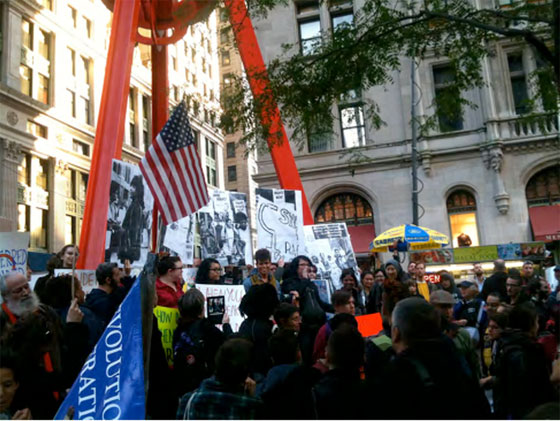
Joie De Vivre: before barricades (transgender teach-in)

Joie De Vivre: before barricades (construction worker talks to media)
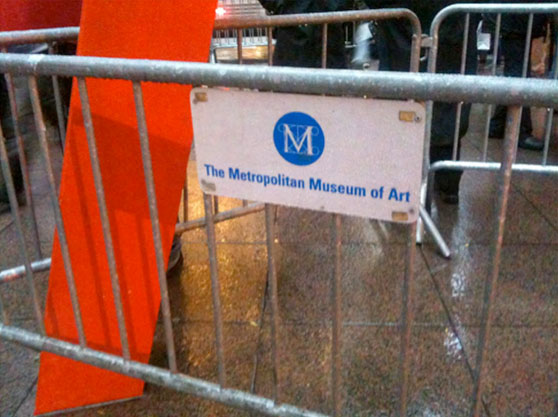
Joie De Vivre: after barricades (with Metropolitan Museum of Art signage)
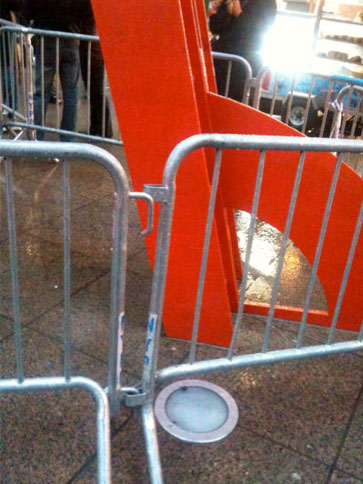
Joie De Vivre: after barricades (with NYPD guards)
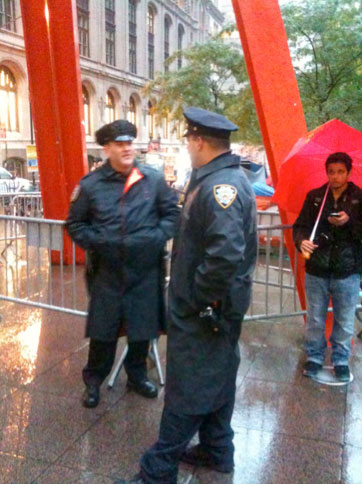
Joie De Vivre: after barricades (with NYPD guards)

Mark Di Suvero's "Joie De Vivre", after barricades (with NYPD Community Affairs guard)
Occupy Brooklyn Rail
 Monday, November 7, 2011 at 03:48PM
Monday, November 7, 2011 at 03:48PM Several pieces came out of the Occupy reading at Bowery Poetry Club last month that Brooklyn Rail has published in the November issue. These include:
- Theodore Hamm's "Letters to the Mayor"
- Jason Flores-Williams' "In the Battle of the Open Heart"
- Occupennial co-organizer Paul McLean's "A Poem for a Sunday Occupational Reading at the Bowery Poetry Club (10.16.2011)"
The publication contains other terrific #OWS coverage, too.
Below is one of the poems Brenda Coultas read at BPC:
A Gaze
I
A man texts a photograph of his meal, but to who? Himself or others?
Others too, texting in a crowd on a 1st aveune as glaciers recede.
They do not feel the fading cold of the ice. Only the heat of the keys strokes.
A man texts crystal water glass pixels to quench real thirst.
I texted forward a rumor of siphoned great lakes water to China. A Chinese bureaucrat texts images of fresh lake water to billions at home.
At the top of a mountain, where only small mamals live, the air is thin and gives me panic. I do not belong above the tree line even though I can drive there. Stopping to send a pic of the lichen sponge by the gift shop on the glacier, the phone lens: an extension of my eyes.
At times, I forget that I am not an extention of the machine until I burn my palms touching a hot metal pot: recoil and remember to use hot pads to protect the flesh fabric that covers the hand bones.
From the glacier tops, bodies of mountian climbers in the dead zone; Will their corpses sweeten or enbitter the drinkers of the Ganges?
The leather shoes of the ice man texted forward. Sometimes, the tap runs while I brush my teeth and empty bathwater down the drain.
The last glass of water sits before you, how will you drink it?
We load the car on hwy 50 the lonliest highway in the USA. It whines through Nevada crossing the poney express route and ancient seabeds. Crinoid stems thirst for the ancient sea.
Last glass of glacier water boils in the kettle. Saffron threads of a viking beard cloud the water glass.
Theft of water, relocation, diverted from its bed. Hydrofracting. I never thought they’d use our water against us.
When we began with this full jug of water, without thinking until the police chased us away from the creek of who owns the water, like who owns the sky. Or that satilite overhead, branded by a private owner over public space.
Wanted to absorb it, to get to the bottom and start all over again. A great anixiety about finishing and throwing it away, with a inch still in the bottom, the backwash.
Who owns the creeks and waterways of this valley? The only legal course is midstream so that anglers can trout fish without tresspass.
Into the last glass, I stir the reindeer scat with a herding stick captured from the thaw.
The water, sometimes they use it against us. I question the interaction between the sythentic (the plastic) and the real inside of the jug on the table. The water is an hour glass, and I write fast as I can before it runs dry
A glass of water from last glacier sits before you on the table, you glaze at the logo of an abundant flowing stream or the name of the spring which somehow sounds pure and far away as an ice berg, calved off and lassoed from the warming world. Even though you know the source is a corporate tap of public water.
Fertilzer runs off into our family well. I used to picture a whale, a Moby Dick under the cornfield, a levathian as the source of our water. Because only a vessel the size of a sperm whale could contain the water that flowed on conmand from the tap. Even though people spoke of the well running dry. Ours magically replenished itself under the blanket of Monstanto crops.
It flows on the green logo and facsmile of a mountain stream of abundant water. Abundant: a 20th century word.
“Natural” is highlighted and in a yellow circle it is written, “contains 16 servings” and there are only two of us left since this, now nearly empty, jug was opened.
 occupennial,
occupennial,  occupy wall street,
occupy wall street,  readings in
readings in  poetry,
poetry,  texts
texts Live Painting at Liberty Square, with Katherine Gressel!
 Monday, November 7, 2011 at 12:47PM
Monday, November 7, 2011 at 12:47PM Hello all, just a heads up that I will be attempting some small plein-air acrylic paintings onsite at the park this afternoon. Was a last-minute realization that I'm able to do it today (due to some schedule changes) which is why I didn't promote it or anything. So it's a bit of an experiment to see what happens when I go there, how people react, etc. Will try to be post some pics later...I should be there between 12:30-5:30 or whenever it gets dark. I welcome comments/suggestions...hopefully i can find at least one more day besides today to go down there and do this before it gets too cold!
Katherine
 notices,
notices,  occupennial,
occupennial,  occupy wall street in
occupy wall street in  art at #ows
art at #ows Occupennial Update, November 7
 Monday, November 7, 2011 at 12:41PM
Monday, November 7, 2011 at 12:41PM Week in Review:
Over the past week Sally has been working on a draft for an outreach letter that will be widely distributed through artist/art-org networks in the NYC area asking for volunteers to work on the Occupennial website as admins on team-task production for populating the databases and the content areas of Occupennial.org. The next phase immediately following our staffing measures (and to some degree simultaneous with it) will involve actually adding Occupant art content to all the areas of our website. Yaelle will be presenting the ready-to-vet iteration of the letter at tonight's Occupennial meeting at 6PM at 60 Wall St.
Also noteworthy is the Occupennial's inaugural project, the storefront installation at Printed Matter, which launched over the weekend in the Chelsea PM location. Kudos to Adrian for coordinating the expo with Max Schumann of PM, Occupy artists and Colab alumni. We will post photos as soon as they come in.
The forms feature of Occupennial, facilitating direct communications from artist wishing to participate in AC/Occupennial art actions/website functions has launched (thanks Monty), and the Performance Guild was the first (and only, so far) to submit a proposal form, which has been posted on the Occupennial site, here: http://www.occupennial.org/performance-guild/ .. Please, Guild folk, use this opportunity to send us a brief introductory/contact form for artists/arts activists who want to get involved, so we can immediately do our part to streamline the processing of inquiries.
The Occupennial calendar has been abandoned in favor of a direct link to NYCGA's event calendar. All are encouraged to populate the NYCGA calendar with AC-originating actions/events. Contact Antonio to do so.
Over the past couple weeks we've been staying aware of the ever-changing topology of Liberty Square/#OWS. The winterizing measures happening have dramatically altered the environment at the movement epicenter. Art has taken a back seat to preparations to make the protest site safe for occupants. A number of expositions focused on the occupation have engendered wide-ranging discussions about how best to proceed, with Occupennial, Arts & Culture, the NYCGA website and more. Occupennial has generated several proposals that are in process, that were temporarily tabled while we considered the emerging inter-group relationships and structures.
These proposals include:
- - OWS/Low Lives
- - Wall Exhibition (Madrid)
- - Line of Sight
- - Eviction
- - The 99% Artist March
- - Artist-led tours at Liberty Square
At tonight's meeting we'll give updates on the status of these projects, and what are next steps will be in their actualization.
Monty Stilson has been developing the Occupennial photo project offline for the past week, after having completed a restructuring of that area last weekend. He will be at the meeting tonight to discuss the new gallery set-up, Occupeyes.org and the Occupeyes Facebook page, and his findings emerging from research done to survey what photographers of the now-global occupation have been doing with their images, and our vision to make Occupennial the clearinghouse/database archive for occupant photography. He has proposed that we create an Occupennial business card with the contact info for the website/admin, that we can distribute when we're out and about at marches, openings and other Occupy-related activities. It's a great idea and perfect timing for our outreach campaign!
Chris Reitz has just completed writing/uploading the introductory entry to our new Occupennial Art History section, which is visible here: http://www.occupennial.org/occupant-ah-journal/ .. We are still refining the formatting a bit. Alan W. Moore contacted Chris and, judging from his initial rough-note, this area of our site shows tremendous promise for generating an art-historical context-based conversation on #OWS, in art historical terms.
In a response to Blithe Riley's efforts to start the already amazing Art & Labor working group, Occupennial is contemplating how we can create an area for databasing relevant info for those of us focused on art-as-occupation issues. Yaelle and I discussed folding Art History/Art & Labor/99% Art Models into a new zine format. We'll discuss that at the meetings, as well.
In case you haven't noticed -- She's a subtle operator -- Yaelle has made some more structural tweaks to the site layout over the past few days, to highlight/prioritize sections that are getting the most usage. We have a bit of a back-up of submitted content, but hopefully by the end of this week, we'll be all caught up.
The primary agenda for tonight's meeting will include the following points of discussion:
- -defining the occupennial as a post- sept 17 database/community of artists.
- -the new outreach letter (!)
- -Monty will present on the Occupennial photo section
- -how to populate the nycga calendar
- -how proposals are streamlined
- -occupennial group supporting autonomous projects
Again, please take the time to contribute to the content-sections of your Occupennial website. If you would like to/have the time to work on a section you're enthusiastic about, please let us know!
Guess that's it for now,
best,
p
[PLEASE FORWARD THIS TO YOUR LISTS/CONTACTS/NETWORKS!!!!!!]
The Occupennial Outreach Letter:
Calling all creative activists! The Wall Street Occupennial seeks enthusiastic participants to work with artists producing projects, performances, and actions within the #Occupywallstreet movement. Artists who already have a project in mind, but NEED participants/assistance, this call is for you too!
The Wall Street Occupennial, a working group of the Arts and Culture Committee, is an urgent call for artists to contribute to the ongoing #OccupyWallStreet (#OWS) movement in New York City and beyond. The Occupennial database (www.occupennial.org) serves to document and archive ongoing artist efforts that are in solidarity with the movement in Zuccotti park, as well as nationally and internationally. It also hosts a forum on 99% and occupation art, lists available spaces and resources, and strives to connect like minded and creative people together to build momentum and really make things happen!
Like the movement as a whole, many of the projects being developed cannot become a reality or be sustained at the hand of one person working alone. It has also become clear in the weeks since the occupation began, that a number of individuals, groups, classes, etc want to join in the movement, especially through creative actions, but are unsure of how to get involved in a movement that is already so developed.
If you are someone who would like to participate in the movement through creative action please reply immediately to occupennial.volunteers@gmail.com with the information requested below and The Wall Street Occupennial will connect you to an artist or team of artists that need your help!
1. Your name and contact information (email and telephone number)
2. Days/times you are available to volunteer.
[This could be more general availability like: Mondays and Thursdays from 1-6 PM, or more specific: Monday 11/7 from 4-10PM, Thursday 11/10 from 3-7 PM, and Friday 11/18 all day. You can be as open or specific as your schedule allows, but keep in mind that the more flexible you are, the more likely we will be able to link you up with a project. If you do not hear from us immediately, don't worry, more and more artists are coming to us every day and that means soon there will be no shortage of projects to dive into!]
3. (Optional) Specific skills/resources you have to offer a project and/or types of projects you are most excited about working on (see www.occupennial.org for examples of all the incredible projects that have happened so far.)
**If you are an artist in need of volunteers/participants to make your project happen:**
Send us a description of your idea, any applicable supporting imagery, and as much information as you have and we will work to connect you with volunteers to help you make it happen! If you have a specific date/time in mind for your project to happen, we will work to find participants for that date, but even better, if you are flexible with the timing, we can direct you to a time that already has a group of eager participants lined up and ready to go!
Please send all replies and inquiries to: occupennial.volunteers@gmail.com
The time is now. We can't wait to meet you!
 occupennial,
occupennial,  update in
update in  updates
updates Rebels on the Street: The Party of Wall Street Meets its Nemesis * by David Harvey
 Monday, November 7, 2011 at 11:35AM
Monday, November 7, 2011 at 11:35AM Rebels on the Street: The Party of Wall Street Meets its Nemesis
David Harvey
Verso Books Blog
The Party of Wall Street has ruled unchallenged in the United States for
far too long. It has totally (as opposed to partially) dominated the
policies of Presidents over at least four decades (if not longer), no
matter whether individual Presidents have been its willing agents or
not. It has legally corrupted Congress via the craven dependency of
politicians in both political parties upon its raw money power and upon
access to the mainstream media that it controls. Thanks to the
appointments made and approved by Presidents and Congress, the Party of
Wall Street dominates much of the state apparatus as well as the
judiciary, in particular the Supreme Court, whose partisan judgments
increasingly favor venal money interests, in spheres as diverse as
electoral, labor, environmental and contract law.
The Party of Wall Street has one universal principle of rule: that there
shall be no serious challenge to the absolute power of money to rule
absolutely. And that power is to be exercised with one objective. Those
possessed of money power shall not only be privileged to accumulate
wealth endlessly at will, but they shall have the right to inherit the
earth, taking either direct or indirect dominion not only of the land
and all the resources and productive capacities that reside therein, but
also assume absolute command, directly or indirectly, over the labor and
creative potentialities of all those others it needs. The rest of
humanity shall be deemed disposable.
These principles and practices do not arise out of individual greed,
short-sightedness or mere malfeasance (although all of these are
plentifully to be found). These principles have been carved into the
body politic of our world through the collective will of a capitalist
class animated by the coercive laws of competition. If my lobbying group
spends less than yours then I will get less in the way of favors. If
this jurisdiction spends on people’s needs it shall be deemed uncompetitive.
Many decent people are locked into the embrace of a system that is
rotten to the core. If they are to earn even a reasonable living they
have no other job option except to give the devil his due: they are only
“following orders,” as Eichmann famously claimed, “doing what the system
demands” as others now put it, in acceding to the barbarous and immoral
principles and practices of the Party of Wall Street. The coercive laws
of competition force us all, to some degree of other, to obey the rules
of this ruthless and uncaring system. The problem is systemic not
individual.
The party’s favored slogans of freedom and liberty to be guaranteed by
private property rights, free markets and free trade, actually translate
into the freedom to exploit the labor of others, to dispossess the
assets of the common people at will and the freedom to pillage the
environment for individual or class benefit.
Once in control of the state apparatus, the Party of Wall Street
typically privatizes all the juicy morsels at less than market value to
open new terrains for their capital accumulation. They arrange
subcontracting (the military-industrial complex being a prime example)
and taxation practices (subsidies to agro-business and low capital gains
taxes) that permit them freely to ransack the public coffers. They
deliberately foster such complicated regulatory systems and such
astonishing administrative incompetence within the rest of the state
apparatus (remember the EPA under Reagan and FEMA and “heck-of-a job”
Brown under Bush) as to convince an inherently skeptical public that the
state can never ever play a constructive or supportive role in improving
the daily life or the future prospects of anyone. And, finally, they use
the monopoly of violence that all sovereign states claim, to exclude the
public from much of what passes for public space and to harass, put
under surveillance and, if necessary, criminalize and incarcerate all
those who do not broadly accede to its dictates. It excels in practices
of repressive tolerance that perpetuate the illusion of freedom of
expression as long as that expression does not ruthlessly expose the
true nature of their project and the repressive apparatus upon which it
rests.
The Party of Wall Street ceaselessly wages class war. “Of course there
is class war,” says Warren Buffett, “and it is my class, the rich, who
are making it and we are winning.” Much of this war is waged in secret,
behind a series of masks and obfuscations through which the aims and
objectives of the Party of Wall Street are disguised.
The Party of Wall Street knows all too well that when profound political
and economic questions are transformed into cultural issues they become
unanswerable. It regularly calls up a huge range of captive expert
opinion, for the most part employed in the think tanks and universities
they fund and splattered throughout the media they control, to create
controversies out of all manner of issues that simply do not matter and
to propose solutions to questions that do not exist. One minute they
talk of nothing other than the austerity necessary for everyone else to
cure the deficit and the next they are proposing to reduce their own
taxation no matter what impact this may have on the deficit. The one
thing that can never be openly debated and discussed, is the true nature
of the class war they have been so ceaselessly and ruthlessly waging. To
depict something as “class war” is, in the current political climate and
in their expert judgment, to place it beyond the pale of serious
consideration, even to be branded a fool if not seditious.
But now for the first time there is an explicit movement to confront The
Party of Wall Street and its unalloyed money power. The “street” in Wall
Street is being occupied – oh horror upon horrors – by others! Spreading
from city to city, the tactics of Occupy Wall Street are to take a
central public space, a park or a square, close to where many of the
levers of power are centered, and by putting human bodies in that place
convert public space into a political commons, a place for open
discussion and debate over what that power is doing and how best to
oppose its reach. This tactic, most conspicuously re-animated in the
noble and on-going struggles centered on Tahrir Square in Cairo, has
spread across the world (Plaza del Sol in Madrid, Syntagma Square in
Athens, now the steps of Saint Paul in London as well as Wall Street
itself). It shows us that the collective power of bodies in public space
is still the most effective instrument of opposition when all other
means of access are blocked. What Tahrir Square showed to the world was
an obvious truth: that it is bodies on the street and in the squares not
the babble of sentiments on twitter or facebook that really matter.
The aim of this movement in the United States is simple. It says: “We
the people are determined to take back our country from the moneyed
powers that currently run it. Our aim is to prove Warren Buffett wrong.
His class, the rich, shall no longer rule unchallenged nor automatically
inherit the earth. Nor is his class, the rich, always destined to win.”
It says “we are the 99 percent.” We have the majority and this majority
can, must and shall prevail. Since all other channels of expression are
closed to us by money power, we have no other option except to occupy
the parks, squares and streets of our cities until our opinions are
heard and our needs attended to.
To succeed the movement has to reach out to the 99 percent. This it can
and is doing step by step. First there are all those being plunged into
immiseration by unemployment and all those who have been or are now
being dispossessed of their houses and their assets by the Wall Street
phalanx. It must forge broad coalitions between students, immigrants,
the underemployed, and all those threatened by the totally unnecessary
and draconian austerity politics being inflicted upon the nation and the
world at the behest of the Party of Wall Street. It must focus on the
astonishing levels of exploitation in workplaces – from the immigrant
domestic workers who the rich so ruthlessly exploit in their homes to
the restaurant workers who slave for almost nothing in the kitchens of
the establishments in which the rich so grandly eat. It must bring
together the creative workers and artists whose talents are so often
turned into commercial products under the control of big money power.
The movement must above all reach out to all the alienated, the
dissatisfied and the discontented, all those who recognize and deeply
feel in their gut that there is something profoundly wrong, that the
system that the Party of Wall Street has devised is not only barbaric,
unethical and morally wrong, but also broken.
All this has to be democratically assembled into a coherent opposition,
which must also freely contemplate what an alternative city, an
alternative political system and, ultimately, an alternative way of
organizing production, distribution and consumption for the benefit of
the people, might look like. Otherwise, a future for the young that
points to spiraling private indebtedness and deepening public austerity,
all for the benefit of the one percent, is no future at all.
In response to the Occupy Wall Street movement the state backed by
capitalist class power makes an astonishing claim: that they and only
they have the exclusive right to regulate and dispose of public space.
The public has no common right to public space! By what right do mayors,
police chiefs, military officers and state officials tell we the people
that they have the right to determine what is public about “our” public
space and who may occupy that space when? When did they presume to evict
us, the people, from any space we the people decide collectively and
peacefully to occupy? They claim they are taking action in the public
interest (and cite laws to prove it) but it is we who are the public!
Where is “our interest” in all of this? And, by the way, is it not “our”
money that the banks and financiers so blatantly use to accumulate
“their” bonuses?
In the face of the organized power of the Party of Wall Street to divide
and rule, the movement that is emerging must also take as one of its
founding principles that it will neither be divided nor diverted until
the Party of Wall Street is brought either to its senses – to see that
the common good must prevail over narrow venal interests – or to its
knees. Corporate privileges to have all of the rights of individuals
without the responsibilities of true citizens must be rolled back.
Public goods such as education and health care must be publically
provided and made freely available. The monopoly powers in the media
must be broken. The buying of elections must be ruled unconstitutional.
The privatization of knowledge and culture must be prohibited. The
freedom to exploit and dispossess others must be severely curbed and
ultimately outlawed.
Americans believe in equality. Polling data show they believe (no matter
what their general political allegiances might be) that the top twenty
percent of the population might be justified in claiming thirty percent
of the total wealth. That the top twenty percent now control 85 percent
of the wealth is unacceptable. That most of that is controlled by the
top one percent is totally unacceptable. What the Occupy Wall Street
movement proposes is that we the people of the United States, commit to
a reversal of that level of inequality not only of wealth and income but
even more importantly of the political power that such a disparity
confers. The people of the United States are rightly proud of the their
democracy but it has always been endangered by capital’s corruptive
power. Now that it is dominated by that power the time is surely nigh,
as Jefferson long ago suggested would be necessary, to make another
American revolution: one based on social justice, equality, and a caring
and thoughtful approach to the relation to nature.
The struggle that has broken out – the People versus the Party of Wall
Street – is crucial to our collective future. The struggle is global as
well as local in its nature. It brings together students who are locked
in a life-and-death struggle with political power in Chile to create a
free and quality education system for all and so begin the dismantling
of the neoliberal model that Pinochet so brutally imposed. It embraces
the agitators in Tahrir Square who recognize that the fall of Mubarak
(like the end of Pinochet’s dictatorship) was but the first step in an
emancipatory struggle to break free from money power. It includes the
“indignados” in Spain, the striking workers in Greece, the militant
opposition emerging all around the world, from London to Durban, Buenos
Aires, Shenzhen and Mumbai. The brutal dominations of big capital and
sheer money power are everywhere on the defensive.
Whose side will each of us as individuals come down on? Which street
will we occupy? Only time will tell. But what we do know is that the
time is now. The system is not only broken and exposed but incapable of
any response other than repression. So we, the people, have no option
but to struggle for the collective right to decide how that system shall
be reconstructed and in what image. The Party of Wall Street has had its
day and failed miserably. How to construct an alternative on its ruins
is both an inescapable opportunity and an obligation that none of us can
or would ever want to avoid.
–
David Harvey teaches at the Graduate Center of the City University of
New York. He is the author of The Enigma of Capital: And the Crises of
Capitalism (Profile Press and Oxford University Press). His forthcoming
book Rebel Cities: From the Right to the City to the Urban Revolution
will be published by Verso in the Spring of 2012.
